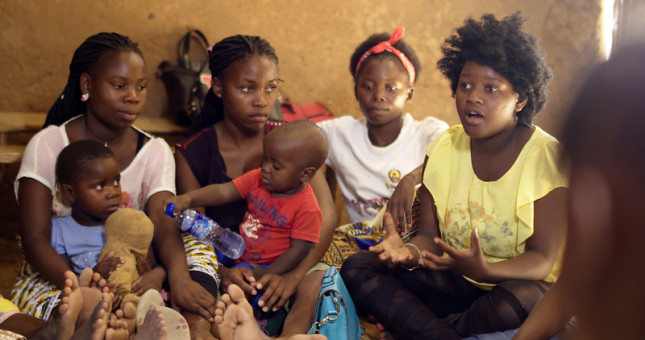-
Covid-19 // Dot-Mom // Guest Contributor
COVID-19 Could Have Devastating Effects on Adolescents’ Sexual and Reproductive Health and Rights
June 24, 2020 By Zara Ahmed
In just a single year, a 10 percent decrease in sexual and reproductive health services in low- and middle-income countries could lead to another 49 million women with unmet need for contraception, according to Guttmacher Institute estimates from April 2020. Other possible effects include another 15 million unintended pregnancies, another 28,000 maternal deaths and 168,000 newborn deaths due to untreated complications, and another 3 million unsafe abortions and 1,000 maternal deaths due to unsafe abortions. The implications are staggering in terms of unmet needs, unintended pregnancies, unsafe abortions, and maternal and newborn deaths in 132 countries that are home to more than 1.6 billion women of reproductive age (15–49 years).
During the COVID-19 pandemic, millions of people could lose access to essential sexual and reproductive health services due to bad policies and structural barriers. Even before the epidemic, many governments around the world failed to adequately support or fund sexual and reproductive health services. The global economic downturn is limiting the financial resources available to governments for such services. Structural issues during the pandemic include lack of supplies and equipment, staff diverted to other types of care, supply chain disruptions, people avoiding preventive care or choosing to deliver outside of facilities, and clinic closures.
These estimates are shocking, but the reality could be much worse if more than 10 percent of services are compromised or disrupted. In addition, the scale of the impact could be many times greater in specific countries, regions, or populations, as the virus and the lack of effective response has and will hit certain populations and areas harder. And this comes on top of the vast, pre-existing need. For example, before the pandemic nearly 220 million women wanted to prevent a pregnancy but were not using a modern form of contraception. That’s far more than the entire population—every adult and child—in Western Europe.
Focus on the Needs of Adolescents
For millions of adolescents around the world, the pandemic could be devastating. Ripple effects of the COVID-19 pandemic are more likely to affect adolescents in particular, as they already have higher rates of unmet need for health services, face greater social and logistical hurdles to accessing care, and have limited access to protective programs, including legal services. During the pandemic, these challenges are heightened and adolescents face increased barriers to confidential sexual and reproductive health care and high-quality and accurate information about sex.
If the lockdown continues for six months, researchers project an additional 31 million cases of gender-based violence. Adolescents are particularly vulnerable to intimate-partner violence so they may be most at risk. Similarly, pandemic-related disruptions in prevention programs may lead to another 2 million cases of female-genital mutilation and 13 million more child marriages over the next decade.
Prior to the pandemic, 132 million girls were not in school; an additional 743 million are now also out of school due to COVID-19 school closures. Past outbreaks have shown that disruptions in education are extremely harmful to young women, not only in terms of lost earnings and education, but also increased vulnerability to gender-based violence and unintended pregnancy. Restrictions to movement prevent young people from going to health clinics, while the closure of schools disrupts sex education curricula and prevents students from visiting school-based health centers that offer sexual and reproductive health care, as well as broader social supports. Some of these challenges can be mitigated by providing care through telehealth, maintaining the confidentiality of all services, prioritizing the continuation of sex education curricula in remote learning, and finding innovative ways to offer preventative and protective services.

Policy Priorities
There’s still time to act but policymakers should move quickly to avert this catastrophe. To do so, they must prioritize five key actions:
- First, policymakers must define and promote sexual and reproductive health care—including safe abortion, contraception, and maternal and newborn care—as essential. This would allow people, including adolescents, to travel for sexual and reproductive health services even in areas under stay-at-home orders or with travel restrictions without fear of legal consequences.
- Alongside private-sector actors, they must shore up and strengthen the national and regional supply chains to make sexual and reproductive health medicines and supplies more accessible to both providers and patients.
- Policymakers must make contraception available without a prescription, decentralize distribution, and facilitate multi-month dispensing of sexual and reproductive health pharmaceuticals. Contraception must be available to people when they want it and where they want it.
- They must adopt innovative models of care, including telehealth, and prevent diversion of resources and staff away from sexual and reproductive health care.
- And finally, they must address the unique needs of vulnerable and marginalized populations, including adolescents and those living in humanitarian settings, as they are contending with barriers exacerbated by the pandemic.
These recommendations apply to policymakers in all countries, both for programs within their borders and in their work with partner governments overseas.
Learning from the Past, Preparing for the Future
It may be possible to learn from past experience with another epidemic. In Sierra Leone, one of the countries most affected by Ebola, decreases in maternal and newborn care due to disrupted services and fear of seeking treatment during the two years of the outbreak contributed to an estimated 3,600 maternal and neonatal deaths. This number approaches the number of deaths Ebola virus directly caused in the country. The Ebola outbreak shows the harmful impacts that can result from an epidemic when governments fail to protect the gains made in sexual and reproductive health over the past several decades.
Outbreaks are inevitable, but catastrophic losses for sexual and reproductive health are not. By learning from prior epidemics like Ebola, putting in place critical resources and systems, and promoting sexual and reproductive health and rights, we can prevent health system disruptions that would have overwhelming, lasting consequences on individuals, families and the global community, particularly the most vulnerable among us.
Thanks go to Adam Sonfield, Ann Biddlecom, Elizabeth Sully, Leah Keller, Megan Donovan, Ruth Dawson, and Taylor Riley for their contributions to this analysis.
Zara Ahmed is Associate Director of Federal Issues at the Guttmacher Institute.
Sources: Guttmacher Institute, International Perspectives on Sexual and Reproductive Health, Save the Children, The Lancet, United Nations Population Fund, World Health Organization.
Lead Photo Credit: Shutterstock.com, All Rights Reserved.
 A Publication of the Stimson Center.
A Publication of the Stimson Center.




